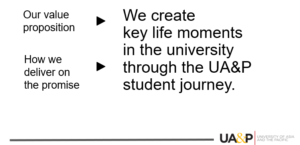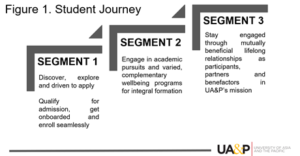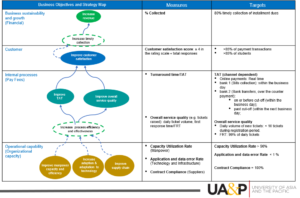This article was first published in the March 2023 newsletter of the Philippine Association of Colleges and Universities (PACU).
The challenge
Student success is usually associated with the timely completion of one’s program of studies. Thus, retention and graduation are metrics often used as measures. While these metrics are important, they only indicate what has happened and are more representative of institutional rather than student success. What if we examine and measure student success from the lens of the students themselves? What experiences do they have along and throughout their journey in the university that were important and satisfying? What were these key touchpoints and how can we be deliberate in our intent to deliver consistent and superior experiences to them? How can we set-up students for success?

Challenge accepted: The Student Journey
The Student Journey (Figure 1) is a series of interactions and touchpoints linked end-to-end to depict the relationship that a student has with the university. It starts with how they ‘discover’ UA&P while in high school (prospect); their application and qualification for admission (candidate); onboarding and registration to their formation and learning (student); transition to their future profession and sustained engagement as alumni (graduate).

We mapped these segments into stages consisting of desirable experiences from the lens of the student. Specific needs in each stage of the journey were likewise identified to understand which parts of the university are involved and aligned these to the university’s strategic objectives, measures, and key performance indicators or KPIs (Figure 2). We posit that when needs, which are perceived as important are satisfied, the student is driven to move along the journey. Furthermore, we can observe, assess, and gain insights on the quality of students’ experiences through data. Doing so will help identify and prioritize improvements that alleviate the struggles experienced along the journey. Altogether, this enables our employees to make informed and data-driven decisions on how to optimize the organization’s capability for sustainability and growth.
UA&P’s Business Process and Analytics (BPA)
The Student Journey identifies key student touchpoints in and throughout a range of business processes that include recruitment, admission, registration, formation, learning and alumni engagement. BPA maps these processes as a series of activities or tasks logically arranged to execute transformation that provide added value to the organization. These processes are at the heart of how the university operates. While the idea of process mapping has been around since the 1920s and is a common practice in the business domain, it has had limited use in higher education settings. Since the management of business process is fundamental to optimizing operations and performance results (productivity) to provide greater value to the end user, HEIs can equally benefit from this. UA&P’s BPA uses Business Process Modeling Notation (BPMN), the industry standard for its process work as part of the larger Business Process Management framework.
Process analytics (i.e., descriptive, predictive and prescriptive) uses process-related data to analyze and innovate our operations in order to sustain or improve these experiences. This helps us determine whether the processes are delivering optimal results; gain insights on how to improve their future performance; make predictions to intervene and adapt when needed, and optimize possible outcomes. This is BPA’s experienced-driven approach to process analytics. This approach takes the perspective of the experience of the student as s/he goes through the processes which, using their data, reveal how they perform. The level of performance of the processes explains the level of experience the student has along the journey.

Value to the organization
What are the benefits of this approach? First, taking on student success as a primary and shared responsibility leads to the alignment of vision, objectives, processes, people, and technology. Having student success as a common measure puts everyone on the same page. It reinforces the shared vision of supporting a consistent and seamless experience. In other words, silos in mindset, goals, units, and levels in the organization are removed. Research has also shown that the most successful organizations are those that avoid working in silos by structuring their processes according to outcomes rather than the specific needs of each function. Second, it aligns the business processes to the university’s strategic objectives, measures, and key performance indicators or KPIs. This ensures that we are measuring what matters. Third, it reinforces a “continuous improvement culture” by leveraging data to inform improvement efforts and/or validate what is working well. Fourth, it underscores the importance of getting the right people (i.e., recruit, develop and sustain talents) following the right processes (includes defining the business or process requirements) to leverage technology to its fullest.
For more information, contact [email protected].
Banner photo by Pixabay.
Leave a Reply